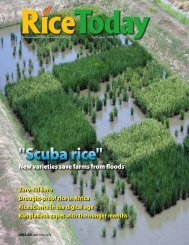A sunburned grain Stamps of approval Pockets of gold in ... - adron.sr
A sunburned grain Stamps of approval Pockets of gold in ... - adron.sr
A sunburned grain Stamps of approval Pockets of gold in ... - adron.sr
You also want an ePaper? Increase the reach of your titles
YUMPU automatically turns print PDFs into web optimized ePapers that Google loves.
Made for theTROPICSCHRIS QUINTANA (3)by Kyung-Ho KangTraditionally grown <strong>in</strong> cooler regions, japonica varieties,which are developed by IRRI, can now be cultivatedunder the warmer climate <strong>of</strong> the Philipp<strong>in</strong>esRice is more than a staple food<strong>in</strong> Asia. It is <strong>in</strong><strong>gra<strong>in</strong></strong>ed <strong>in</strong>the culture—not to mentionadapted to the topography andclimate <strong>of</strong> particular countries—thatsometimes respective ethnic groups canbe dist<strong>in</strong>guished from each other basedon the type <strong>of</strong> rice they grow and eat.While South and Southeast Asians, forexample, prefer long-<strong>gra<strong>in</strong></strong> rice such asbasmati and jasm<strong>in</strong>e, Northeast Asiansprefer medium-<strong>gra<strong>in</strong></strong> rice, known asjaponica. This latter type <strong>of</strong> rice thrives<strong>in</strong> temperate areas. Hence, <strong>in</strong> countrieswhere it is not traditionally grown,consumers need to pay more to obta<strong>in</strong> it.This may soon change, however, asthe International Rice Research Institute(IRRI) has recently developed twotemperate japonica rice varieties released<strong>in</strong> the Philipp<strong>in</strong>es. The Rice TechnicalWork<strong>in</strong>g Group <strong>of</strong> the National SeedIndustry Council through the NationalCooperative Tests Network, led by thePhilipp<strong>in</strong>e Rice Research Institute, hasapproved two temperate japonica ricecultivars, NSIC Rc170 or IRRI 142 andNSIC Rc220 or IRRI 152, for largescaleplant<strong>in</strong>g. This development isexpected to provide local farmers withhigher returns, and subsequently, allowconsumers to enjoy this quality rice at amore affordable price.Adapt<strong>in</strong>g to the tropicsIRRI’s japonica rice breed<strong>in</strong>g program,which is now known as GermplasmUtilization Value Added (GUVA),started <strong>in</strong> 1991, <strong>in</strong> collaboration withthe Republic <strong>of</strong> Korea, to develophigh-quality, high-yield<strong>in</strong>g temperatejaponica rice cultivars that can adaptand grow <strong>in</strong> the tropical zone. Underwarm conditions, most temperatejaponica rice varieties show stuntedgrowth and develop weak tillers,small panicles, and premature head<strong>in</strong>gbecause these varieties are sensitive toshort daylength and high temperature.So, dur<strong>in</strong>g the <strong>in</strong>itial stage <strong>of</strong> thebreed<strong>in</strong>g program, every year, scientistsidentified and selected, from the KoreanSeed Multiplication Project’s nursery,germplasm (plant genetic material)that showed good performance <strong>in</strong> thePhilipp<strong>in</strong>es. These selections servedas base materials to develop breed<strong>in</strong>gpopulations <strong>of</strong> temperate japonica ricethat can adapt to tropical conditions.They were found to be less sensitiveto longer exposure to sunlight andhigher temperature, and also did notdiffer much <strong>in</strong> plant growth under thevary<strong>in</strong>g environments <strong>of</strong> Korea and thePhilipp<strong>in</strong>es.The first <strong>of</strong> the two cultivars <strong>in</strong>the Philipp<strong>in</strong>es, NSIC Rc170 or IRRI142, now called MS11, was released<strong>in</strong> 2008. MS11 is a cross between twovarieties from the Republic <strong>of</strong> Korea,namely, J<strong>in</strong>mibyeo and Cheolweon 46.J<strong>in</strong>mibyeo has high <strong>gra<strong>in</strong></strong> quality, whileCheolweon 46 has high resistance topests and diseases <strong>in</strong> tropical conditions.The product, MS11, is a semidwarf (90cm), early-matur<strong>in</strong>g (112 days) variety,and has the typical characteristics <strong>of</strong>japonica <strong>gra<strong>in</strong></strong>—short rounded shape,low amylose content (15.5%), and lowgelat<strong>in</strong>ization temperature. In the threeseasonmultilocation trials from the wet34 Rice Today April-June 2010

















